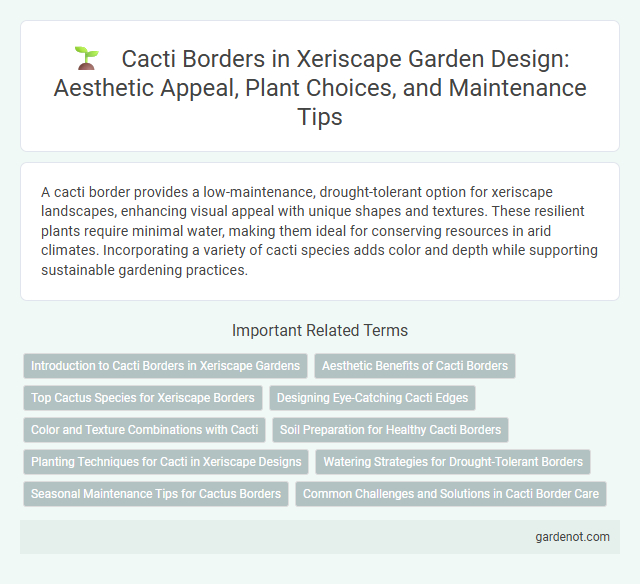A cacti border provides a low-maintenance, drought-tolerant option for xeriscape landscapes, enhancing visual appeal with unique shapes and textures. These resilient plants require minimal water, making them ideal for conserving resources in arid climates. Incorporating a variety of cacti species adds color and depth while supporting sustainable gardening practices.
Introduction to Cacti Borders in Xeriscape Gardens
Cacti borders are essential elements in xeriscape gardens, providing drought-resistant and low-maintenance landscape solutions. These spiny succulents thrive in arid climates, helping conserve water while adding texture and visual interest to garden edges. Incorporating native cactus species enhances biodiversity and supports sustainable gardening practices in xeriscaping design.
Aesthetic Benefits of Cacti Borders
Cacti borders enhance garden aesthetics by introducing unique textures and striking silhouettes that create visual interest throughout the year. Their vibrant blooms and diverse shapes provide dynamic color accents while maintaining a low-maintenance, drought-resistant landscape. Incorporating cacti as borders offers an eco-friendly solution that harmonizes beauty with sustainability in xeriscaping design.
Top Cactus Species for Xeriscape Borders
Top cactus species for xeriscape borders include Opuntia (prickly pear), which offers vibrant blooms and edible pads, and Echinocereus (hedgehog cactus), prized for its dense spines and colorful flowers. Agave species provide dramatic architecture and drought tolerance, while Ferocactus delivers bold barrel-shaped forms that enhance border texture. Incorporating these cacti creates low-maintenance, water-efficient borders ideal for arid landscapes.
Designing Eye-Catching Cacti Edges
Cacti borders create striking xeriscape edges with their unique textures and vibrant green hues, offering both low-maintenance and drought-resistant benefits. Arranging a variety of cacti species with different heights and shapes enhances visual interest and natural patterns along pathways or garden perimeters. Strategic placement maximizes sunlight exposure while ensuring proper drainage, promoting healthy growth and a captivating landscape feature.
Color and Texture Combinations with Cacti
Cacti borders create vibrant visual interest by combining diverse species with varying shades of green, from deep emerald to silvery blue, accented by splashes of red, yellow, or pink blooms. The textured interplay between spiky saguaro, round barrel cacti, and the feathery pads of prickly pears adds dynamic depth and tactile contrast. These color and texture combinations enhance xeriscape designs by providing low-water, low-maintenance beauty that thrives in arid conditions.
Soil Preparation for Healthy Cacti Borders
Soil preparation for healthy cacti borders involves selecting well-draining, sandy or gravelly soil that prevents root rot and mimics natural desert conditions. Amending soil with organic matter like compost enhances nutrient availability while maintaining aeration essential for cactus root health. Proper soil pH between 6.0 and 7.5 supports optimal nutrient uptake, ensuring resilient and vibrant cacti growth.
Planting Techniques for Cacti in Xeriscape Designs
Planting techniques for cacti in xeriscape designs emphasize well-draining soil with a sandy or gritty texture to prevent root rot. Position cacti to maximize sunlight exposure while allowing adequate spacing for air circulation and growth. Incorporating mulch consisting of volcanic rock or gravel helps retain moisture and reduces weed growth, enhancing overall plant health in arid landscapes.
Watering Strategies for Drought-Tolerant Borders
Cacti borders thrive with infrequent deep watering, promoting extensive root systems that maximize water absorption in arid conditions. Implementing drip irrigation or soaker hoses minimizes water waste by delivering moisture directly to the plant base. Mulching around cacti conserves soil moisture and reduces evaporation, enhancing drought resilience in xeriscape gardens.
Seasonal Maintenance Tips for Cactus Borders
Pruning spent flowers and removing dead or damaged cactus pads during early spring boosts healthy growth for cactus borders. Applying a light layer of mulch, such as gravel or decomposed granite, helps retain soil moisture and control weeds through dry seasons. Inspecting for pests regularly and treating infestations promptly ensures the long-term vitality of xeriscape cactus borders.
Common Challenges and Solutions in Cacti Border Care
Cacti borders often face challenges such as overwatering, pests like spider mites, and inadequate sunlight, which can lead to rot and poor growth. Solutions include implementing drip irrigation systems to provide precise water control, using insecticidal soap or neem oil to manage pests, and positioning cacti in areas with at least six hours of direct sunlight daily. Regular inspection and soil amendments with well-draining materials help maintain optimal conditions for healthy cacti border development.
Cacti border Infographic

 gardenot.com
gardenot.com